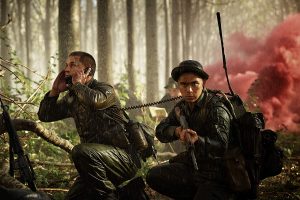 Danger Close: The Battle of Long Tan ★★★
Danger Close: The Battle of Long Tan ★★★
THE Battle of Long Tan is a now celebrated moment for Australia’s Vietnam War veterans and their families.
On the 18th of August in 1966, Australian and New Zealand soldiers held back an advancing North Vietnamese force despite being vastly outnumbered.
They had two factors in their favour which proved decisive for the 108 men required to fight 2,500 in the jungle rubber plantations of Phuoc Toy Province.
Firstly, they were able at critical moments to call on artillery cover and, secondly, rely on the belligerence of their immediate officers to disobey orders and make important, balanced decisions in the field.
Danger Close: The Battle of Long Tan is an overdue and well-made tribute to the 90 survivors and 18 killed.
That is not to downplay the lives of the hundreds of North Vietnamese who also died but, arguably for good or bad, this film is told from the one side.
In concentrating almost solely on the Battle the film tends to avoid many of the war genre’s human story cliches.
It also also means there is plenty of time devoted to providing a clear picture of the military tactics that were employed and the key moments involved.
Queenslander Travis Fimmel, who played Ragnarok in television’s Vikings, plays the lead role of the commanding officer in the field, Major Smith.
Fimmel is an unorthodox actor who seeks his own particular way into a role. As in Vikings, here he again seems a little awkward and uneasy at first but gradually he commands the attention and has some of the best relationship moments.
Apart from Richard Roxburgh, the rest of the cast is relatively unknown which helps convey the inexperience of Delta Company – the average age of the men in real-life was 20 – juxtaposed with the dilemmas faced by their leaders who are expected to treat the men as numbers on a map and part of a larger tactical struggle.
There is particularly good use of silence in the moments before another intense battle scene, some strong visuals and minimal histrionics.
Director Kriv Stenders, best known for the two Red Dog films, is able to control the gore quotient while still conveying the horrors of combat.
At all times Stenders and his five writers (usually a bad sign) are able to depict clearly what is happening, the intentions and consequences of each contact with the enemy.
This is one of the better Australian war films and a fitting tribute to those involved and their families.